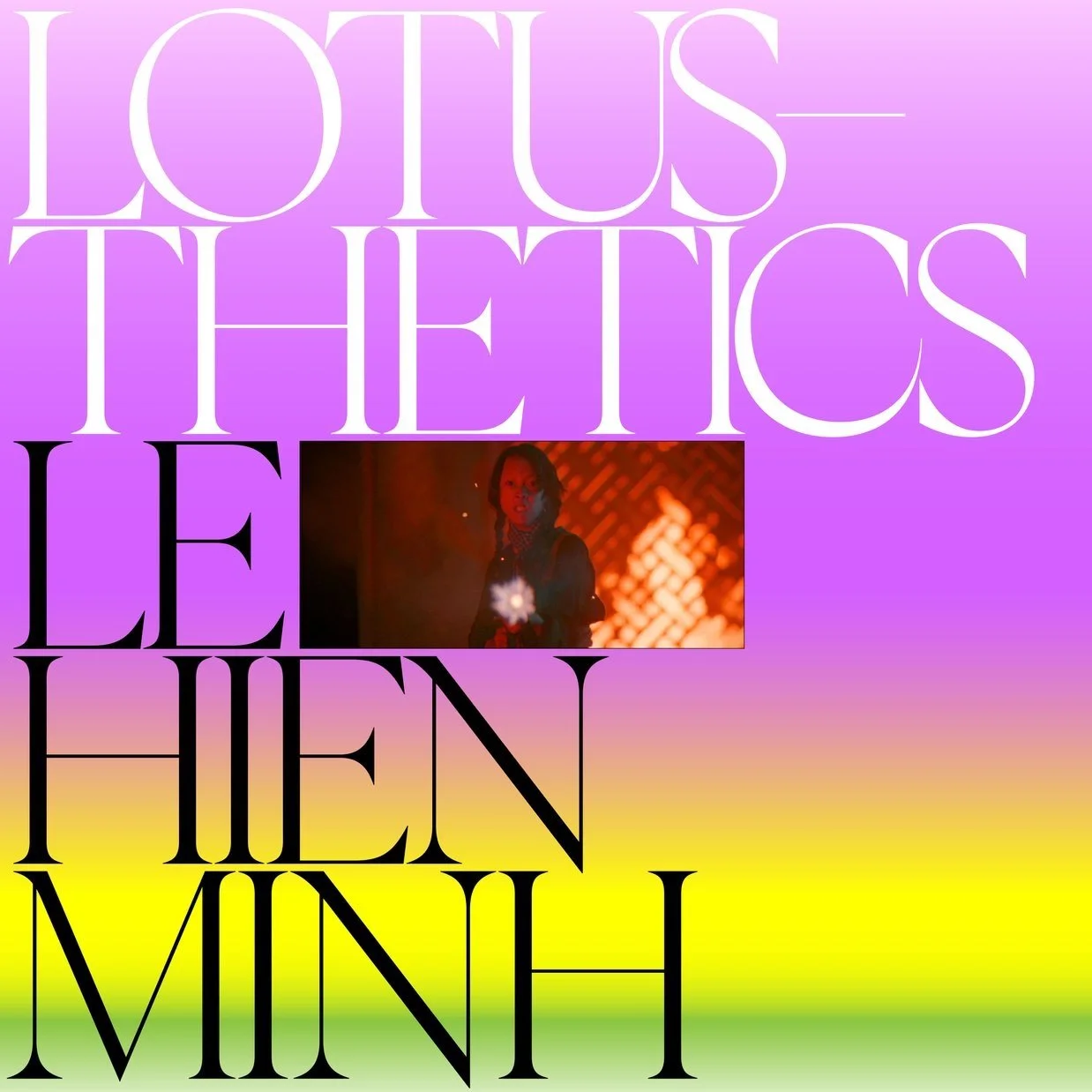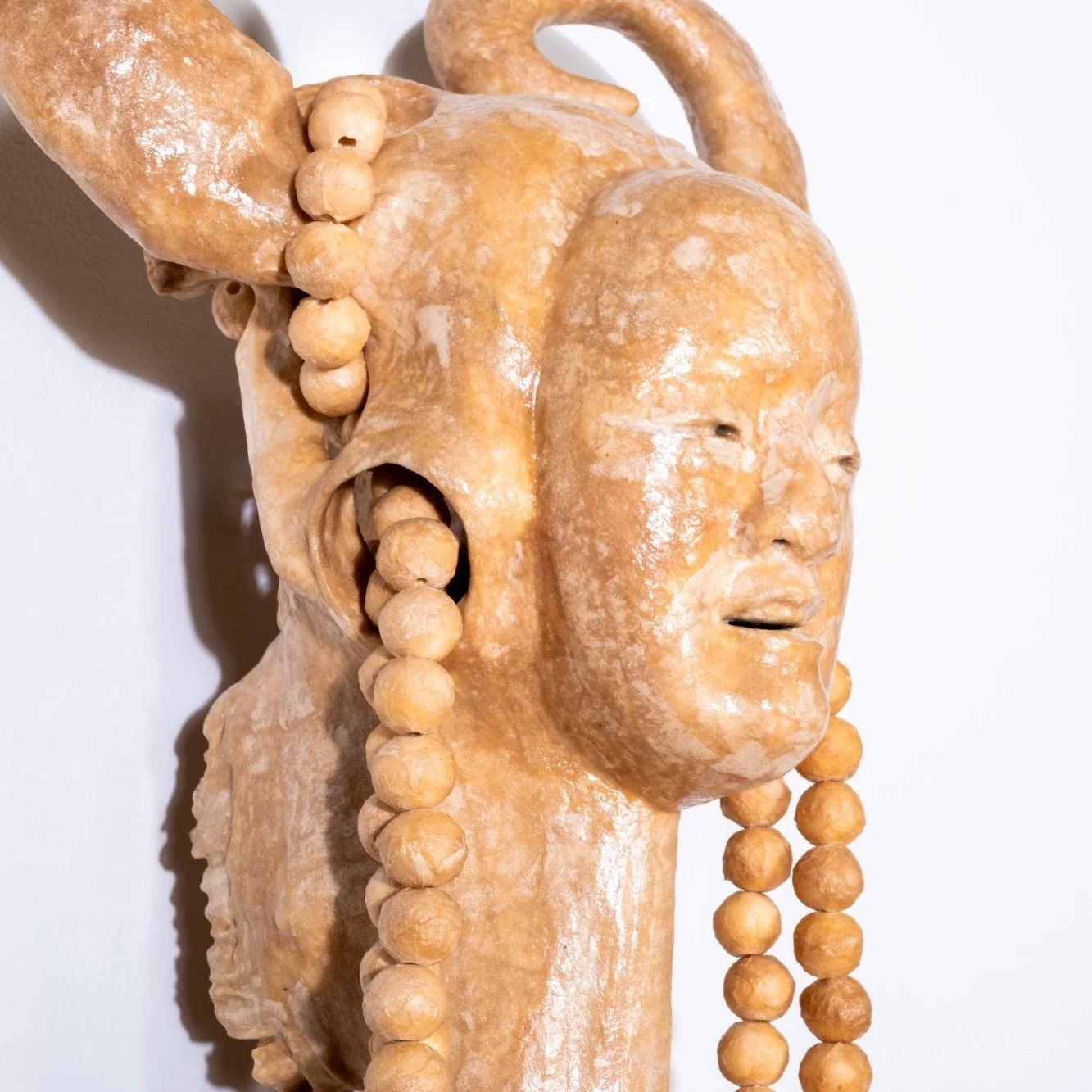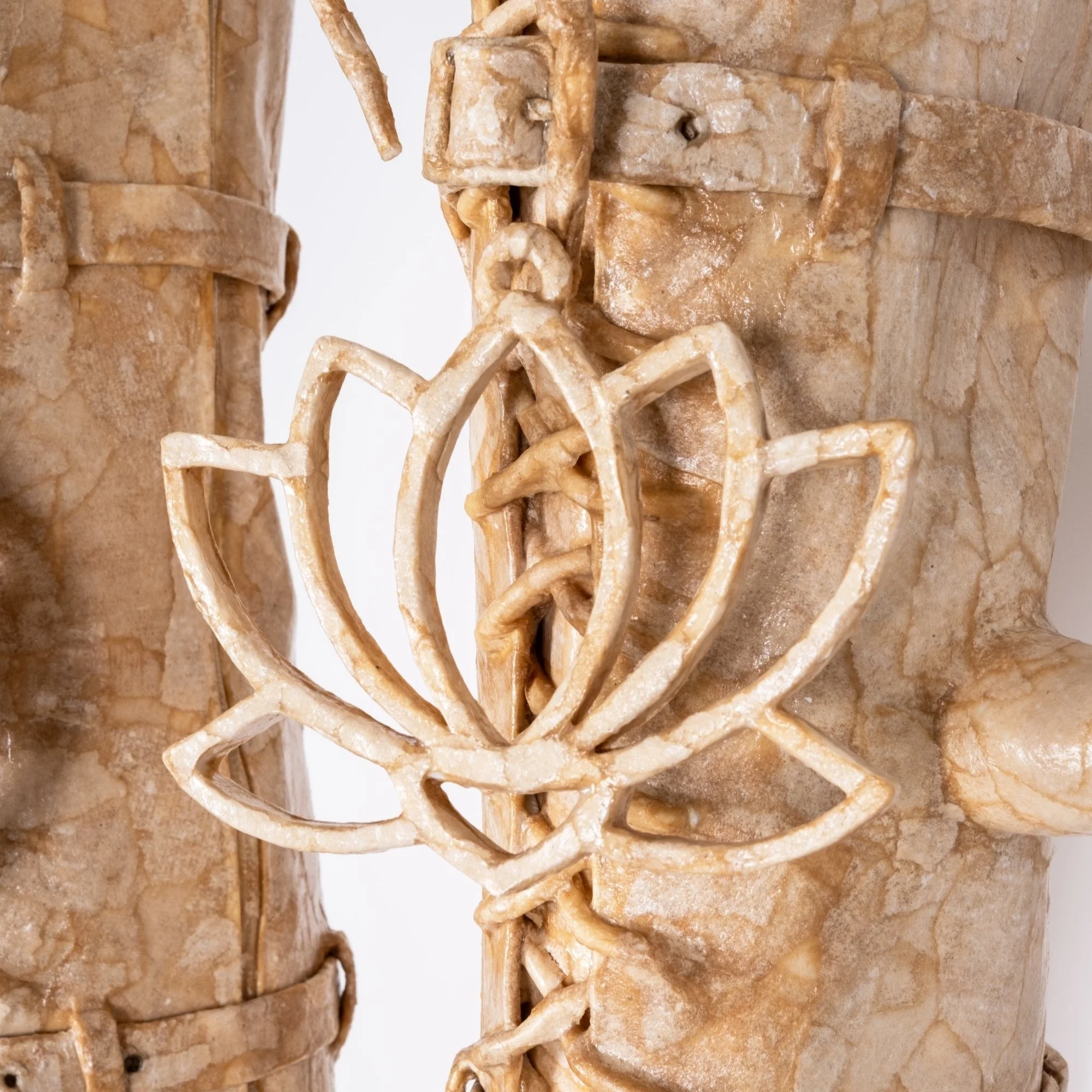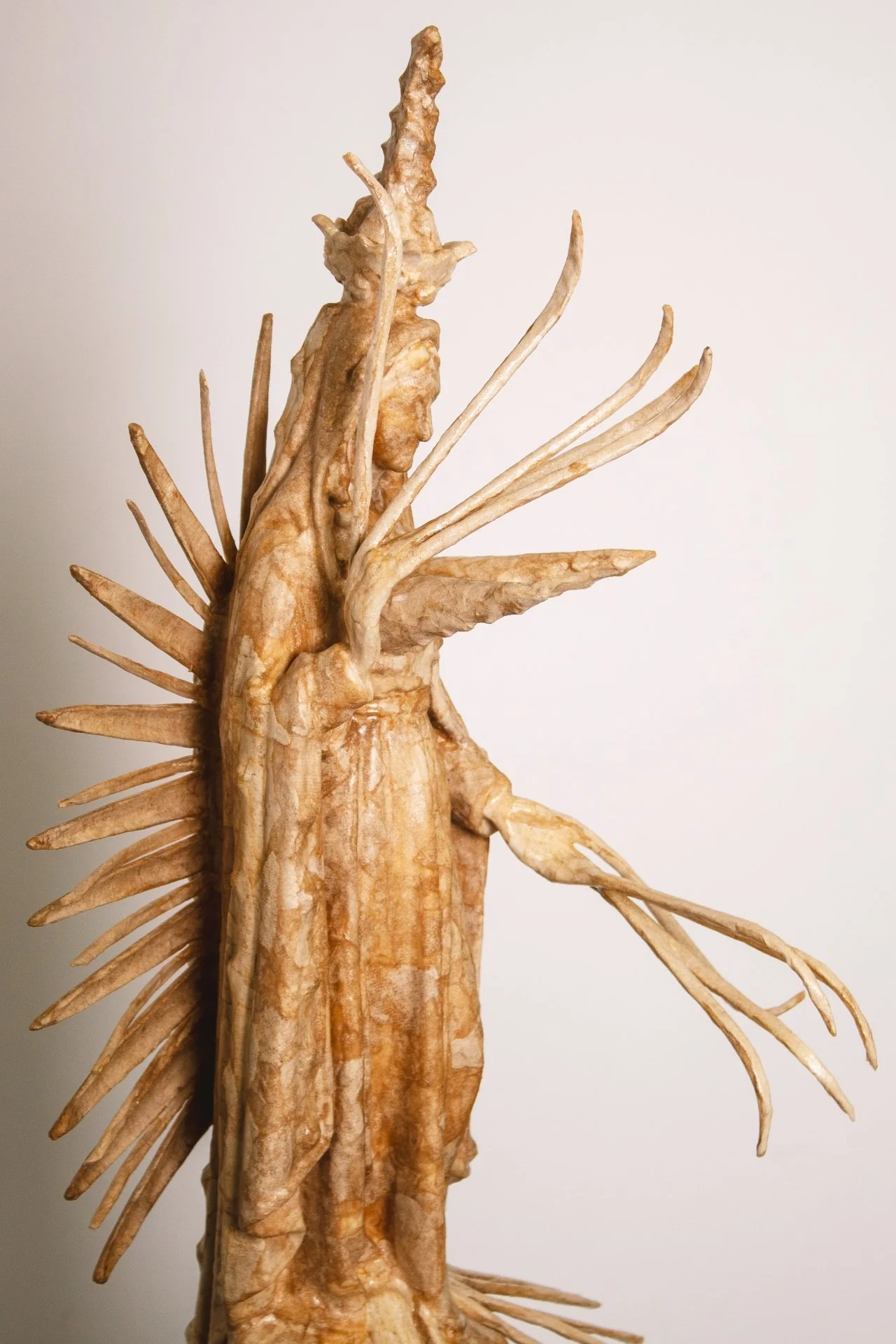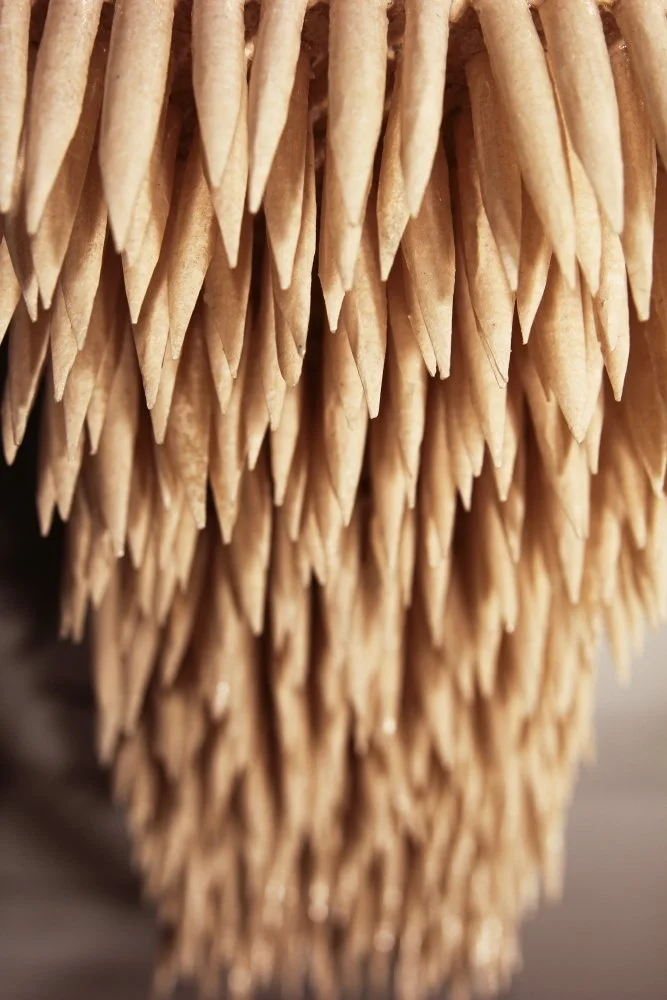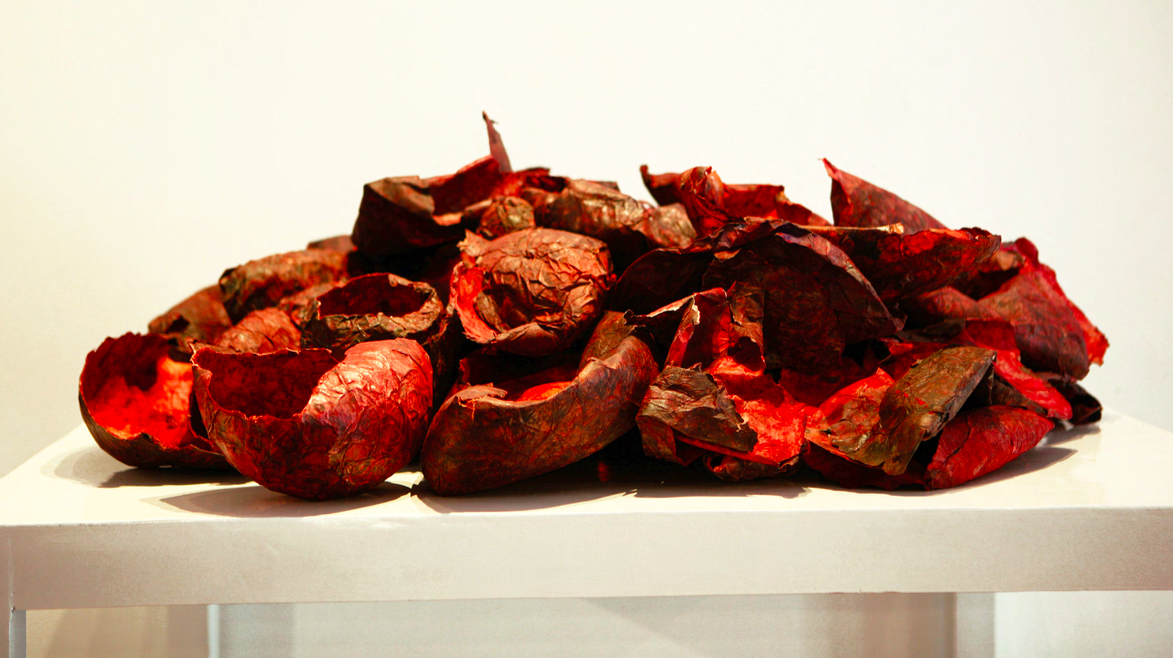Lotusthetics
2025, 3:44 min.
Lotusthetics is a collage of moving-image work composed of hundreds of images drawn from a wide range of sources, including Hollywood films, news media, historical archives, celebrity culture, and spiritual iconography from both American and Vietnamese contexts.
Asian women in the United States are often viewed through a reductive lens due to their minority status and limited representation in popular culture. Portrayals frequently rely on narrow cultural touch-points or tropes, including Orientalist and Ornamentalist stereotypes such as the “Dragon Lady.” Lotusthetics interrogates and reconfigures these American cultural symbols of female Asian-ness, combining them with imagery from Vietnamese contexts.
I weave these visuals together to create stark juxtapositions between disparate worldviews. The legacy of the Vietnam War serves as a bridge, connecting these two perspectives. The result is a surreal, sometimes jarring meditation that transcends familiar symbols to evoke something new—what I term a “matriarchal vision.”
Me So Horny
2025
Traditional Vietnamese handmade Dó paper, buffalo skull, ceramic mask, wood, natural jute fiber, and sound. Dimension variable (skull section is 24 ¹∕₄" × 15 ¹∕₈" × 11 ³∕₅ in | 61 × 38 × 28cm).
Me So Horny is part of an ongoing body of work in which I critically examine how American pop culture has influenced and altered popular perceptions of Vietnamese female identity within the American context. This body of work explores the layered impact of pop culture shaped by war, Orientalism, fantasy, and media stereotypes. Drawing from sources such as Hollywood war films, American pop music, and traditional Vietnamese motifs, I weave these elements into objects that evoke the uncanny. Viewed through a surrealist and metaphysical lens, the work appears to emerge from a parallel reality, both seductive and unsettling. The outcome is a collection of matriarchal power objects imbued with an otherworldly aura.
The artwork Me So Horny takes its title from a phrase widely recognized in American pop culture, first spoken by a Vietnamese sex worker character in Stanley Kubrick’s film Full Metal Jacket and later sampled in the 1990s hip-hop song by 2 Live Crew. Here, I reclaim and transform this loaded phrase through a symbolic assemblage of materials. A buffalo skull, an animal with spiritual and cultural significance in Vietnam, is merged with the face of an Asian woman and adorned with an oversized strand of prayer beads. A sound component transforms the infamous phrase into a monk-like chant, re-contextualizing it into a trance-inducing, ritualistic experience. The result is a haunting work that oscillates between the sacred and the profane, the grotesque and the sublime, the unsettling and the seductive.
It becomes a surreal monument to misrepresentation and a confrontation with the layers of cultural fantasy projected onto Asian female bodies, at once a site of reclamation and resistance.
Photo by Laurel Hauge
One Of These Days These Boots Are Gonna Walk All Over You
2025
Traditional Vietnamese handmade Dó paper, bioplastic, thigh-high boots, wood. 39,5 × 18 × 12 in | 100,5 × 45 × 30 cm
This work is part of an ongoing series in which I critically examine how American pop culture—shaped by war, Orientalism, and media stereotypes—has influenced and altered perceptions of Vietnamese female identity in the American context. I’m interested in the layered effects of these pop culture forces, exploring how the trappings of imposed identity might be broken down and transformed to imagine a different reality.
The artwork’s title, One Of These Days These Boots Are Gonna Walk All Over You, is taken from Nancy Sinatra’s 1966 song, which was famously featured in Stanley Kubrick’s film Full Metal Jacket during a scene in which a Vietnamese sex worker approaches American soldiers during the Vietnam War. At the center of the work is a surreal pair of thigh-high boots (a style commonly associated with sex work) fused with horn-like forms that evoke the buffalo, an animal deeply rooted in Vietnamese cultural symbolism. I cover the entire surface with Vietnamese handmade Dó paper, using it like skin, and adorn the boots with oversized ornamental charms such as the lotus, Vietnam’s national flower. Together, these elements construct a power object belonging to a female warrior from another dimension.
By fusing fetishized Western tropes with authentic Vietnamese iconography, the work recasts Orientalist fantasies of Asian female hyper-sexualization into icons of strength and defiance—blurring the boundaries between history and fantasy, memory and invention, object and self.
Some Body to Love
2024
Traditional Vietnamese handmade Dó paper, bioplastic, wood. 3 ⅙ x 4 x 29 in | 8 x 10 x 74 cm
Some Body to Love continues my pursuit of matriarchal power objects imbued with an otherworldly aura.
The artwork examines Vietnamese womanhood in the U.S., asking how Western biases, shaped by war, affect and distort identity. Some Body to Love anthropomorphizes an enlarged Ka-Bar knife—standard issue for U.S. soldiers in the Vietnam War—with a woman wearing a Nón Lá, the conical hat famously associated with Asia. The blade emerges menacingly from between her legs, reversing the violent thrust of the weapon. At its core, the work confronts the sexual violence embedded in wartime history while testifying to women’s capacity for extraordinary resilience.
The title Some Body to Love is a play on the title of a hit song by the 1960s American psychedelic rock band Jefferson Airplane, Somebody to Love, which helped popularize and commercialize the hippie movement in America.
Image 1: Installation view, Disobedient Bodies: Reclaiming Her (2025), Sundaram Tagore Gallery, Singapore. Courtesy of the Artist and Sundaram Tagore Gallery.
Images 2 and 3: Photo by Laurel Hauge
Apocalypse Nail
2024
Traditional Vietnamese handmade Dó paper, bioplastic, 24K gold paint. 15 ¼ x 45 ⅝ x 6 in | 38.5 x 115 x 15.5 cm
Apocalypse Nail closes a series titled Ornamentalism, focusing on the Vietnamese nail industry, and launches a broader inquiry into Vietnamese womanhood in the United States. The work examines how Western cultural biases, shaped by the enduring effects of war, impact individual and collective identity.
Apocalypse Nail merges the AK-47 rifle—a weapon associated with Vietnamese soldiers—with manicured female hands adorned with ultra-long, gold painted, prosthetic nails. By pairing “enemy” weaponry with symbols of the Vietnamese American nail-industry, the work exposes the absurdity of defining Vietnamese identity through these types of narrow markers. At the same time, the fusion creates a new form: a matriarchal power object that challenges inherited narratives and reclaims agency.
Installation view, Disobedient Bodies: Reclaiming Her (2025), Sundaram Tagore Gallery, Singapore. Courtesy of the Artist and Sundaram Tagore Gallery.
Ornamentalism
2022–2024
From 2022 to 2024, I developed a comprehensive body of work titled Ornamentalism, centering on Vietnamese female nail technicians in the U.S nail industry. For Vietnamese immigrants, nail technician is a highly sought-after job that offers an economic foothold, and has become a shorthand for Vietnamese women in America.
Through sculpture, installation, drawing, and moving image, the project uses the nail salon industry as a lens to critically examine and challenge societal perceptions and ingrained biases of Asian women. The series addresses different facets of the Asian female experience in America, connecting personal stories of nail technicians to broader socio-economic contexts, revealing the complex effects of living with pervasive biases. Ornamentalism honors these technicians' resilience, self-determination, and personal power, emphasizing their often-overlooked labor.
Installation view, A Village Before Us (2023), John David Mooney Foundation, Chicago, U.S. Left to right: Nail Women, Blessed Lady of the Nail, Minority Model, Invisible Dragon
Photo by Laurel Hauge
Blessed Lady of the Nail
2024
Traditional Vietnamese handmade Dó paper, acrylic, resin, carved wooden octagonal stand. 29 x 12 ½ x 12 ⅞ in | 74 x 31.5 x 32.5 cm
Vietnamese cosmology is populated by a diverse array of divine deities, each dedicated to safeguarding a specific aspect of everyday life—like the God and Goddess who watch over the family kitchen.
Drawing on this heritage, I created Blessed Lady of the Nail for my Ornamentalism series. This work brings to life a new guardian spirit for Vietnamese women working in the U.S. nail industry, blending elements of Eastern and Western devotional imagery into a single matriarchal figure. Here, the nail transcends its ordinary purpose to emerge as a talisman of resilience and protection. The resulting form is both fantastical and poetic, adding to the world of matriarchal icons while asserting a contemporary vision of female empowerment.
Photo by Mia
Invisible Dragon
2023
Traditional Vietnamese handmade Dó paper, wood, acrylic, resin. Top sculpture: 17 ¼ x 5 ¾ x 7 ½ in | 44 x 15 x 19.5 cm. Bottom sculpture: 11 ⅛ x 4 x 17 in | 28.5 x 11 x 43.5 cm.
Invisible Dragon—from my Ornamentalism series, takes aim at the “dragon lady” stereotype that casts Asian women as exotic, manipulative threats. The artwork features a pair of disembodied female hands emerging from lotus blossoms, posed in Eastern religious gestures and adorned with strikingly long pink nails. Wall mounted and theatrically lit, the sculpture cast strange shadows that suggest something threatening hidden underneath the surface. The play of ornamental Asian femininity and ominous silhouette exposes the trope’s ironic nature: Asian women must appear delicate and pleasant, yet are feared as covertly dangerous.
By amplifying that tension, Invisible Dragon reclaims the stereotype, revealing the matriarchal power that lies beneath the pleasing surface of Asian femininity.
Photo by Laurel Hauge
Nail Women
2023
Single-channel. High-definition video (color, sound), 36:55 min.
Nail Women is a long-form moving image project that delves into the experiences of Vietnamese female nail technicians in Chicago. The project compiles a series of interviews exploring concepts of selfhood and cultural identity within a distinct segment of the Vietnamese diaspora.
Since 2023, I have been interviewing technicians in various Chicago salons, capturing the dynamic atmospheres of their workplaces. Aligned with the tradition of American Social Realism—a movement focused on capturing the realities of working-class life, often advocating for social change—and inspired by Julia Reichert's approach to social documentary filmmaking, I give the Vietnamese female nail technicians the space to speak for themselves, offering a powerful perspective rarely seen. This approach provides a strong platform for personal narratives that illuminate broader social issues, enabling the subjects' voices to emerge through intimate, interview-based storytelling.
The question, "Who is a Vietnamese woman?" serves as the video's central inquiry, delving into the complexities of Vietnamese identity shaped by the enduring impact of the Vietnam War. It examines the tension between those living in Vietnam and those who have migrated or were born in America, highlighting the interplay of historical legacies, social systems, and wealth disparities.
The question “Who is a Vietnamese woman?” extends beyond Vietnamese identity, delving into layers of American society where Asian women often confront specific stereotypes. The perspective of Vietnamese women in the Nail Women video provides insight into their psychology, exploring whether stereotypical notions of Asian femininity may influence how they perceive themselves. The personal viewpoints of Vietnamese nail technicians living in the U.S. regarding Vietnamese femaleness offer a glimpse into the roots of bias, prompting the question of how bias becomes entrenched—whether as something imposed upon a group or individual, something self-imposed, or both.
Contemplating one's existence and the interconnected facets of selfhood, culture, and society, the Nail Women video delves into profound layers. It surpasses a mere exploration of individuals, venturing into the intricate realms of cultural and social identity. It prompts questions about the impact of culture and society on self-understanding of identity—examining how deeply these influences shape beliefs and consciousness, intricately weaving into an individual's awareness and manifesting as personal beliefs.
Installation view at A Village Before Us (2023), John David Mooney Foundation, Chicago, U.S.
Photo by Laurel Hauge
Minority Model
2023
Traditional Vietnamese handmade Dó paper, wood, acrylic nails. 36 x 26 x 9 in | 91 x 66 x 23 cm
Minority Model—from my Ornamentalism series—dissects the Model Minority myth. Emerging during the civil rights movement in the mid-20th century, the Model Minority stereotype in the U.S. flattens Asians America into a monolithic, compliant group, casting Asian women as passive and obedient.
In the sculpture, thousands of nearly identical acrylic nails—stand-ins for Vietnamese nail technicians—are arranged in repetition to form an object reminiscent of the punji-stick traps used during the Vietnam war. Here, passive objects, symbolic of female beauty are multiplied into a field of sharp points that jut toward the viewer. By reshaping salon nails into a defensive weapon, Minority Model exposes the “trap” behind the myth’s facade and warns against the homogenization of Asian female identity, while at the same time illustrates the collective power of the Vietnamese immigrant community.
Installation view, Disobedient Bodies: Reclaiming Her (2025), Sundaram Tagore Gallery, Singapore. Courtesy of the Artist and Sundaram Tagore Gallery.
The Gods of Expectation
from Five Questions series (2019–ongoing).
2021
Traditional Vietnamese handmade Dó paper, wooden lacquer statues, washing machine, metal kitchen sink, metal faucet, wooden lacquer tables, wooden lacquer bed, polypropylene tube. Dimensions variable.
The Gods of Expectation amalgamates matriarchal icons with symbols of domestic labor in three sculptures—Divine Cycle, Divine Constant, and Divine Source. Each sculpture incorporates a goddess from Đạo Mẫu, Vietnam’s Mother-Goddess folk religion rooted in the country’s primeval, once-matriarchal society. Đạo Mẫu has survived multiple shifts in Vietnam’s social order including feudal and colonial periods. In 1945, Đạo Mẫu was banned and was not officially permitted to be practiced until the late 1990s.
The three sculptures in The Gods of Expectation are connected to each other by an umbilical cord, and are displayed alongside five questions painted on the wall: Who is Woman? What is Woman? Where is Woman? Why is Woman? When is Woman? Viewers are invited to interact by placing responses inside the washing machine, sink, or on the bed.
This work examines societal expectations imposed on women, particularly regarding domestic duties and childbearing, by questioning why these responsibilities are perceived as inherent "expectations." Fundamentally, by interweaving symbols of female power with symbols of female duty, I create matriarchal monumental objects that disrupt and reimagine our collective understanding of femininity through a surreal lens of divine transformation.
Installation view, Within / Between / Beneath / Upon (2021), The Factory Contemporary Arts Center, Ho Chi Minh City, Vietnam
Photo by Tri Nguyen
Divine Cycle
2021
Traditional Vietnamese handmade Dó paper, wooden lacquer statue, washing machine, wooden lacquer table, polypropylene tube. 88 x 24 x 24 in | 223 x 60 x 60 cm
Divine Cycle is a sculpture from the installation The Gods of Expectation. Inspired by the totem pole traditions of Indigenous peoples of the Pacific Northwest of North America, this work features a Goddess from Vietnam’s ancient matriarchal religion—Đạo Mẫu—stacked on top of a washing machine, which is in turn stacked on a traditional lacquer table.
Viewers are invited to interact by responding to five questions—Who is Woman? What is Woman? Where is Woman? Why is Woman? When is Woman?—and placing their responses inside the washing machine.
This work delves into societal expectations imposed on women, particularly focusing on domestic duties. It questions why these responsibilities are perceived as inherent "expectations" imposed on women. By interweaving symbols of female power with symbols of female duty, I create matriarchal monumental objects that disrupt and reimagine our collective understanding of femininity through a surreal lens of divine transformation.
Installation view, Within / Between / Beneath / Upon (2021), The Factory Contemporary Arts Center, Ho Chi Minh city, Vietnam
Photo by Tri Nguyen
Divine Constant
2021
Traditional Vietnamese handmade Dó paper, wooden lacquer statue, wooden lacquer table, metal kitchen sink, metal faucet, polypropylene tube. 64 x 54 x 30 in | 162 x 138 x 76 cm
Divine Constant is a sculpture from the installation The Gods of Expectation. In this work, I transform a traditionally carved lacquer altar table by integrating a metal sink and faucet into its surface. Atop the table sits a Goddess from Vietnam’s ancient matriarchal religion—Đạo Mẫu.
Viewers are invited to engage by placing their responses to five questions—Who is Woman? What is Woman? Where is Woman? Why is Woman? When is Woman?—inside the kitchen sink.
This work examines societal expectations placed on women, particularly surrounding domestic duties, and challenges why these roles are seen as inherent "expectations." By merging symbols of female power with those of female duty, I create monumental matriarchal objects that disrupt and reimagine femininity through a surreal lens of divine transformation.
Installation view, Within / Between / Beneath / Upon (2021), The Factory Contemporary Arts Center, Ho Chi Minh city, Vietnam
Photo by Tri Nguyen
Divine Source
2021
Traditional Vietnamese handmade Dó paper, wooden lacquer statue, wooden lacquer bed, polypropylene tube. 32 x 64 x 31 in | 81 x 164 x 79cm
Divine Source is a sculpture from the installation The Gods of Expectation. In this work, I transform a traditionally carved lacquer platform into a single-sized bed. Reclining atop the bed is a Goddess inspired by a deity from Vietnam’s ancient matriarchal religion—Đạo Mẫu. Unlike the traditional seated pose of such statues, the Goddess is depicted in a reclining position, a posture typically reserved for male Buddhas.
Viewers are invited to engage by placing their responses to five questions—Who is Woman? What is Woman? Where is Woman? Why is Woman? When is Woman?—on the bed.
This piece explores societal expectations placed on women, particularly regarding childbearing and care work, and questions why these roles are viewed as inherent "expectations." By blending symbols of female power with those of female duty, I create monumental matriarchal objects that challenge and reimagine femininity through a surreal lens of divine transformation.
Installation view, Within / Between / Beneath / Upon (2021), The Factory Contemporary Arts Center, Ho Chi Minh city, Vietnam
Photo by Tri Nguyen
The States of Mind
from the Five Questions series (2019–ongoing).
2019
Traditional Vietnamese handmade Dó paper, polystyrene, acrylic.
The States of Mind installation is exhibited at Myorakuji Temple—a historic Buddhist site in Fukuoka City, Japan. The resident monks welcomed the work into their garden, creating a productive tension between spiritual contemplation and the matriarchal imagery at the heart of the piece.
The installation features a set of female icons in five distinct poses, inspired by ancient Venus figurines from various cultures, such as the Venus of Willendorf. Each female icon represents a universal human emotional state—triumph, relaxation, contentment, resilience, and weariness. Within the garden’s quiet ritual space, viewers are invited to participate by contemplating and responding to five questions—Who is Woman? What is Woman? Where is Woman? Why is Woman? When is Woman?—and affixing their answers to the figures.
In this way, The States of Mind becomes a vessel for collective reflection on womanhood, with the responses becoming an integral part of the work itself. The work seeks to explore a universal human emotional spectrum, transcending personal backgrounds and cultural boundaries.
Twice a year, temples in Fukuoka open their doors to the public at night, granting rare access to spaces that are typically closed. This unique event attracts thousands of visitors to Myorakuji Temple, offering an opportunity for cultural and spiritual engagement. It was during this special occasion that The States of Mind was displayed at the temple. While the work was on view, hundreds of visitors added their reflections to the piece, eventually covering all five statues in overlapping layers of handwritten responses.
The last three pictures show that the interactive aspect was continued three years later at the exhibition held at the Fukuoka Asian Art Museum in 2021, where the sculptures continued to engage with the public, collecting responses from viewers.
Installation view, The States of Mind (2019), Myorakuji Temple, Fukuoka, Japan
Installation view, Making & Experiencing Asian Cultures (2021), Fukuoka Asian Art Museum, Fukuoka, Japan
Divine Feminine
2019
Traditional Vietnamese handmade Dó paper, wooden lacquer statues, wooden lacquer tables, gold leaf.
Divine Feminine is a site-specific installation created for Sculpture Expanded: Moving Laboratory of Public Art in Helsinki, Finland. This project, part of one of the largest citywide sculpture exhibitions, spanned six months and featured works displayed throughout public spaces. Given the outdoor setting and extended duration of the exhibition, I wanted to create a work that could respond to the ever-changing elements.
The inspiration for Divine Feminine draws from traditional Vietnamese female religious iconography, specifically the Đạo Mẫu folk religion. For this work, I commissioned three wooden statues of female deities from this tradition. They were carved in Sơn Đồng village, Vietnam, using techniques passed down through generations. Each statue was lacquered in gold leaf and then covered with circular pieces of Vietnamese Dó paper.
The installation was displayed in various locations across Helsinki, including public parks and the city’s port. Over the six-month period, natural weathering transformed the statues, gradually revealing the gold beneath the paper surface.
Divine Feminine explores Vietnamese matriarchal imagery while reflecting my intention to resurrect matriarchal histories and symbols of Vietnamese culture on a global stage. It also invites reflection on the nature of “foreignness,” examining how cultural symbols adapt, endure, and transform when situated in unfamiliar contexts.
Exhibition date in 2019:
17.5 – 30.6.2019 Redi, Helsinki
1.7 – 15.8.2019 Ravintola Töölönranta, Helsinki
15.8 – 15.9.2019 Allas Sea Pool, Helsinki
Exhibition date in 2020:
10.6 – 6.9.2020 Veteran’s Park, Espoo Keskus
Biological Being
2017
(Worms Revisited)
Traditional Vietnamese handmade Dó paper, lacquer, hand-braided jute rope, dry powder pigment, cement.
The installation Biological Being features a large female figure inspired by ancient fertility icons such as the Venus of Willendorf. She clutches a giant rope-like form resembling braided hair, which unfurls into a vast net entangled with fleshy, enigmatic forms. These strange, weighty appendages appear emerge from her from sex. Though monstrous in scale and burden, she bears them with determination, refusing to release them. Suspended in a surreal space of struggle, she hovers between inheritance and resistance.
This work explores the ongoing expectations and realities imposed on women’s bodies through the lens of biological reproduction. Across cultures, a woman’s value has long been linked to her capacity to bear children. Even in societies that advocate autonomy and progress, this biological narrative remains inescapable. Regardless of whether a woman chooses to have children, she is often framed by the figure of “the mother”, which is perceived as both natural and necessary.
Biological Being invites viewers to confront the inherited weight of gendered expectation, and the ways biological determinism continues to shape the social and psychic realities of women’s lives.
Installation view, bugs, birds…equations of the future (2017), MoT+++, Ho Chi Minh city, Vietnam
Photo by Nguyen Hoang Oanh.
The Production of Man
2016
(Balls Revisited)
Traditional Vietnamese handmade Dó paper, wooden lacquer table, glass jar, dry powder pigment.
The installation The Production of Man centers on a phallic black lacquer altar topped with a large glass jar containing more than 20,000 handmade paper balls, blood red in color, which overflow and spill onto the floor like liquid. The altar references traditional Northern Vietnamese home altars used for ancestor veneration, while the jar resembles those used to brew herbal spirits believed to enhance male virility.
Facing this tableau, a hand-painted Confucian phrase is displayed on the opposite wall: “NHIỆM VỤ LỚN NHẤT CỦA PHỤ NỮ LÀ SINH RA MỘT ĐỨA CON TRAI.” (A woman’s greatest duty is to produce a son.)
By juxtaposing these elements, the work interrogates the enduring societal pressure placed on Vietnamese women to produce male heirs. It highlights how over a thousand years of Chinese rule, and the embedded influence of Confucian ideology, have shaped Vietnam’s gender norms. Though colonial powers have long departed, patriarchal systems remain deeply rooted in the culture.
The Production of Man critiques these entrenched gender roles and their entanglement with power, lineage, and cultural hierarchy. Through form, language, and repetition, the installation becomes a monument to the women who struggle within these patriarchal systems and a confrontation with the structures that continue to define their worth.
Installation view, Hạt | Tim (2016), Dia Projects, Ho Chi Minh city, Vietnam
Nhà | Home
2004. Revisited 2017
Traditional Vietnamese handmade Dó paper, dry powder pigment.
In 2004, I started working on a piece called Home. At that time, I had spent two and a half years in the USA, where I earned my Bachelor's Degree in Fine Art. Despite establishing a home for myself in a foreign country, I decided to return to Vietnam instead of staying and working in the U.S. Now, I confronted the inevitability of leaving everything behind. It became clear to me that I couldn't bring the majority of my belongings back to Vietnam. It was at this time I started working on an artwork.
Using Dó paper, I began casting various objects from around my apartment, ranging from my television, table, and chairs to pots, bowls, chopsticks, paintbrushes, tubes of paint, handbags, cosmetics, cellphone, books, shoes, and more. Over the next six months, I cast hundreds of objects, each exposed to the elements in an empty yard next to my apartment—subjected to rain and buried in snow during the fall and early winter. This transformative process turned these objects, once my possessions, into something new, resembling ancient artifacts discovered in an archaeological dig. Before returning to Vietnam I exhibited them as a farewell to my life in America.
In 2O17, thirteen years later, in 2017, for the Taiwan Annual Exhibition, I revisited Home. The passage of time had rendered many of the objects unrecognizable, transforming them into mysteries that were once familiar to me. To accompany the exhibition, I created a map reflecting the growing disconnect between myself and the objects. While part of me held onto memories, attempting to recall the details, another part slowly accepted the fading of those memories.
Installation view, Limbo (2004), Warsaw Project Space, Cincinnati, U.S.
Installation view, Home | Land (2017), Taiwan Annual 2nd, Taipei, Taiwan
The Room
2014
Traditional Vietnamese handmade Dó paper, lacquer platform, chrome, white curtains, wooden frames, fiberglass, lights, photograph.
Installation The Room is a collaboration between my husband, Gregory Jewett, and me, installed in a designated gallery space within our home.
The room features a prominent white partition wall, dividing it into two sections. Upon entering the exhibition, viewers first encounter Gregory's side, where a luminous fiberglass bear stands, facing the partition and positioned atop an abstract black and white photograph. Within the wall directly behind the bear, a chrome sign with the illuminated word Tilt is installed.
On the opposite side of the partition, a large square black lacquer platform takes center stage, situated in the middle of the space. Atop this platform rests a chrome "bed," on which lie two small sculptural objects crafted from Dó paper and pigment, showcasing organic shapes. Adjacent to the platform, two white curtains are suspended within white wooden frames. Concealed behind the curtains are two round lights attached to the wall, with one slightly smaller than the other.
During the public opening, we closed off the exhibition area with a rope partition, intentionally limiting access to prevent viewers from entering the space and experiencing the work up close.
The Room serves as a recreation and interpretation of a shared memory between Gregory and me. Each side of the room encapsulates our individual perspectives within this shared memory, presenting a complex, mysterious space—a dreamlike aberration frozen in time. The Room stands as an expression of two distinct viewpoints converging on a shared moment that was simultaneously isolating and unifying, an experience that we never fully shared yet will perpetually hold in common.
Installation view, The Room (2014), ATIQ Saigon, Ho Chi Minh city, Vietnam
Sách Từ Điển | Dictionaries
2012
Traditional Vietnamese handmade Dó paper.
The installation Dictionaries is a commemorative installation consisting of one thousand sculptural objects in the form of large-scale dictionaries, created for the exhibition Bố Hạo at the Vietnam National Fine Arts Museum in Hanoi. The work marks the ten-year anniversary of my father’s passing. He was a linguist who worked at the Institute of Hán-Nôm Studies, specializing in Hán-Nôm—the pre-Latin, Sino-Vietnamese written language.
Over the course of two years, I hand-sculpted one thousand life-sized dictionary-shaped forms using traditional Vietnamese Dó paper. Installed directly on the floor, the books fill the museum space from wall to wall, creating an immersive field of quiet remembrance. This work is a journey into memory—tracing its textures, searching its edges, discovering what remains and what has faded. It speaks to both the fullness of love experienced and the profound absence left in its wake.
The painstaking act of making Dictionaries became a ritual of grief and healing, a way to externalize emotion and transform loss into something tactile, weightless, and luminous. The repetition of form, material fragility, and meditative labor offered me both comfort and clarity in navigating the space between presence and disappearance.
Together with the installation Dictionaries, I made a book CÒN LẠI | RỜI RẠC as a companion piece. The book has 18 individual cards. Each card has 2 sides.
One side contains images of my dad's belongings or pictures of us. The other side contains my writing of my memories of my dad. During the time of creating this book, I didn’t seek other people's memories. I want it to be my memories only, even if it is misshapen because of time, but it is purely mine.
CÒN LẠI | RỜI RẠC is part of the Joan Flasch Artist’s Book Collection, which is one of the School of the Art Institute of Chicago's special collections, and the Asian Art Archive in America.
Installation view, Bố Hạo (2012), Vietnam Nation Fine Arts Museum, Hanoi, Vietnam
Tượng | Statues
2011
Traditional Vietnamese handmade Dó paper, wooden lacquer statues.
The installation Statues was installed on the 4th floor of Park Armory Avenue in New York City. Constructed in 1880, the Park Armory served as the headquarters and administrative hub for the 7th New York Militia Regiment, an infantry regiment in the Union Army during the American Civil War. Since 2006, the building has been repurposed as a venue for performances and exhibitions.
The artwork Statues showcased a collection of wooden statues, each enveloped in Dó paper, providing them with a uniform color and covering reminiscent of army uniforms. Following the exhibition, I left the work at the Armory for anyone interested, thus disbanding the group. In this manner, the work exists in two forms: initially as a cohesive group and subsequently as scattered individuals.
Installation view, Watusi Regime (2011), Park Armory Avenue, New York, U.S.
Thân thể | Body
2010
Traditional Vietnamese handmade Dó paper.
I molded my own body with Dó paper and placed it outdoors amidst the grass and trees, exposing it to various natural elements such as sun and rain. Over 60 days, I observed the transformation of the cast body as it changed, even experiencing a moment when a dog carried away my face to an unknown location. Ultimately, my body disintegrated completely into the earth.
The body and mind undergo perpetual change—subjected to growth and decline, construction, and deconstruction. Upon death, our bodies return to the earth, reverting to their fundamental building blocks like dirt, water, and air, sustaining other forms of life. This continual state of flux defines impermanence for me. My artwork, an extension of myself and an embodiment of an idea exists in the material world and is inherently impermanent. Crafted from delicate materials sourced from nature, my works naturally transform, eventually reverting to their elemental forms, along with the essence of myself contained within.
Installation view, Vermont Studio Center, Vermont, U.S.
Chim | Birds
2009
Traditional Vietnamese handmade Dó paper, traditional Korean bean powder.
Birds is an installation composed of approximately 700 hand-sculpted paper objects, each resembling a small, abstract bird. The forms are arranged in concentric circles across the floor, radiating outward like a mandala. Their uniform orientation and geometric order create a sense of quiet symmetry and collective unity.
In Vietnamese, the word “bird” (chim) functions as a child-like slang term for both male and female genitalia—a linguistic ambiguity that blurs binary gender associations. This work subtly plays with that layered meaning, using abstraction and repetition to explore the fluidity of gendered language and symbolic form.
By invoking this linguistic double entendre through a soft and meditative visual arrangement, Birds invites viewers to reflect on how language, gender, and form are socially encoded—and how they might be opened up to new readings. The installation creates a gentle yet subversive space where ambiguity is not a limitation, but a possibility.
Dimensions: 3m diameter
Installation view, So Close Yet So Far Away (2009), The Incheon Women Artists’ Biennale, Incheon, South Korea.
Mây | Clouds
2005–2006
Traditional Vietnamese handmade Dó paper, hand braided jute rope.
The artwork Clouds was created in Hanoi in 2005, initially inspired by the desert clouds of the American Southwest. Over two years, I slowly developed this piece, and its shape, color, and texture underwent significant transformations due to the exceptionally high humidity in Hanoi. Throughout this period, mold would emerge, spreading within the work. In response, I would consistently apply a diluted bleach solution to control it, discovering that baby powder helped maintain dryness and protected the piece against humidity. The interplay of mold, bleach, and baby powder became integral to the final piece's aesthetic, contributing texture, color, and influencing its overall form.
This process, allowing nature to modify my work while simultaneously safeguarding it against natural elements, is a crucial aspect of my creative process. Even after I consider a work finished, natural elements persist in impacting it, contributing to its ongoing evolution in various ways.
Installation view, Dó10 (2013), Ho Chi Minh City Museum of Fine Arts, Ho Chi Minh City, Vietnam
Sâu | Worms
2007
Traditional Vietnamese handmade Dópaper, lacquer, hand braided nylon rope.
Installation view, Lê Hiền Minh (2007), Viet Art Center, Hanoi University of Fine Arts, Hanoi, Vietnam
Hạt | Balls
2004
Traditional Vietnamese handmade Dó paper, dry powder pigment.
The artwork Balls is one of my early creations using Dó paper, standing out as one of the initial works crafted through the repetition of a singular form.
Installation view, Rite of Passage (Crossing the Threshold) (2004), Chidlaw Gallery, Art Academy of Cincinnati, Cincinnati, U.S.
Trứng | Egg
2004
Traditional Vietnamese handmade Dó paper, dry powder pigment.
The work Eggs is one of the first sculptural objects that I made with Dó paper. It is also among the initial works where I employed the repetition of a single form.
Installation view, Rite of Passage (Crossing the Threshold) (2004), Chidlaw Gallery, Art Academy of Cincinnati, Cincinnati, U.S.
Tranh | Painting
2002
Traditional Vietnamese Handmade Dó Paper, Dry Powder Pigment, Photographs
Selected paintingswere created in 2002 when I first started using Dó paper to create artwork.
In this series, I engaged in experimentation with Dó paper, exploring techniques like applying powder pigment to stain the paper akin to dyeing cloth, as well as incorporating methods such as cutting out holes and tearing the paper.
Following this series, my focus shifted towards sculptural work.
